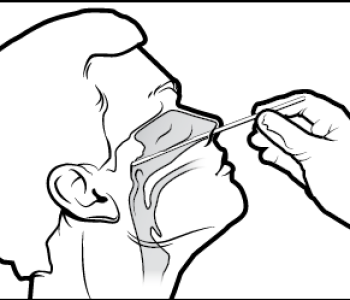
To report a confirmed or suspect case of pertussis, complete the Reportable Disease Fax Form or call the reporting line: (360) 678-2301, Monday–Friday, 8:00 a.m. - 4:30 p.m. After hours: call (360) 678-7270 or Washington State Department of Health (206) 418-5500.
Overview
Pertussis is common and very contagious. It is caused by Bordetella pertussis. The bacteria infect cilia in the upper respiratory tract. Early symptoms are mild, like the common cold. Patients often experience violent coughing fits (paroxysms). These can be followed by high-pitched gasps (a “whoop” sound) as the patient tries to inhale. Coughing spells can lead to gagging, vomiting, loss of consciousness, incontinence and broken ribs.
Babies are at high risk for severe complications. Most pertussis deaths occur in babies under 2 months of age.1 Very young infants with pertussis do not always cough. They may experience apnea, poor feeding and failure to thrive. Severe complications include pneumonia and convulsions.

Pertussis epidemics occur every few years. In 2012, Washington had almost 5,000 reported cases.
Vaccination is the best way to prevent pertussis. Immunity wanes over time, but is highly effective in infants and young children. Maternal immunization at 27 to 36 weeks gestation has been shown effective in preventing pertussis in the first weeks of life.
Symptoms
Early symptoms include coryza and mild non-purulent conjunctival injection, followed by development of an initially mild cough. Fever is absent or minimal. The cough becomes severe and paroxysmal and inspiratory whoop and/or post-tussive vomiting may occur. Disease in older children and adults may be much less severe, manifesting as just a prolonged (longer than 2 weeks) cough. Residual coughing may last up to 3 months. Very young infants may present with apnea, poor feeding and/or failure to thrive. A history of immunization does not preclude the diagnosis. Pertussis is under-diagnosed in adults. The incubation period is 5-21 days (usually 7-10 days).
Diagnosis
Polymerase chain reaction (PCR) is currently the most common method of diagnosis. Culture of nasopharyngeal secretions is the “gold standard”—however, Bordetella pertussis is very difficult to culture and PCR provides more rapid and sensitive results. For the best diagnostic yield, obtain specimens within the first 2 weeks of infection and before the patient receives antibiotics. A negative PCR and/or a negative culture does not rule out pertussis. Serology is not recommended for diagnostic purposes. See instructions on how to collect nasopharyngeal specimens.
Treatment and Chemoprophylaxis
Macrolides are the preferred treatment. If pertussis is suspected, a preferred antibiotic should be given without waiting for test results. Antibiotic prophylaxis should be administered to all members of the household and high-risk asymptomatic close contacts of a confirmed case. Women in the last trimester of pregnancy and infants younger than 1 year of age are considered high-risk. Healthcare or childcare workers who may have close contact with people at high risk for acquiring severe or complicated disease should be given prophylaxis. See table for prescribing details.
Immunization
Immunization is highly effective for infants, and since widespread immunization, pertussis rates have fallen more than 75%. However, immunity from pertussis immunization quickly wanes, and public health efforts are now highly focused on preventing newborn cases of pertussis through vaccination of pregnant women at 27-36 weeks of every pregnancy. Passive antibody transfer from mother to fetus has been shown to offer protection in the first weeks of life when prevention of pertussis is critical.3,4 This recommendation was made in 2012 and is supported by the American College of Obstetricians and Gynecologists (ACOG) and the American College of Nurse-Midwives. The primary series is DTaP (diphtheria, tetanus and pertussis) given at 2 months, 4 months, 6 months and 15-18 months
of age (the fourth dose can be given as early as 12 months of age if 6 months have passed since the third dose). A booster is given at age 4-6 years. Tdap (tetanus, diphtheria and pertussis) immunization should be given at age 10 or 11 and is recommended as a 1-time dose for adults, except for pregnant women as noted above. Every effort should be made to protect newborns from this disease by immunizing their mothers and those close to them, including caregivers and healthcare workers.
Recommended Regimens for Treatment and Prophylaxis of Pertussis2
| Age Group | Azithromycin | Erythromycin | Clarithromycin | TMP-SMZ (Alternative) |
| Younger than 1 month | Recommended agent. 10mg/kg per day in a single dose for 5 days. Limited safety data available. | Not preferred. Erythromycin is associated with infantile hypertrophic pyloric stenosis. Use if azithromycin is unavailable; 40-50 mg/kg/day in 4 divided doses for 14 days | Not recommended. Safety data unavailable. | Contraindicated for infants younger than 2 months (risk for kernicterus). |
| 1-5 months | 10 mg/kg per day in a single dose for 5 days. | 40-50 mg/kg per day in 4 divided doses for 14 days. | 15 mg/kg per day in 2 divided doses (maximum 1 g per day) for 7 days. | Contraindicated for infants younger than 2 months. For infants older than 2 months, TMP 8 mg/kg per day, SMZ 40mg/kg per day in 2 divided doses for 14 days. |
| Infants older than 6 months and children | 10 mg/kg in a single dose on day 1, then 5 mg/kg per day (maximum 500 mg) on days 2-15. | 40-50 mg/kg per day (maximum 2 g per day) in 4 divided doses for 14 days. | 15 mg/kg per day in 2 divided doses for 7 days. | TMP 8 mg/kg per day, SMZ 40 mg/kg per day in 2 divided doses for 14 days. |
| Adults | 500 mg in a single dose on day 1 then 250 mg per day on days 2-5. | 2 g per day in 4 divided doses for 14 days. | 1 g per day in 2 divided doses for 7 days. | TMP 320 mg per day, SMZ 1,600 mg per day in 2 divided doses for 14 days. |
Additional Prevention Measures
Persons with confirmed or suspected pertussis should be considered contagious and excluded from school, daycare or work until five days after the start of appropriate antimicrobial therapy or three weeks have passed after the onset of paroxysmal cough. Healthcare workers with pertussis, or healthcare workers who are symptomatic after exposure to a case, should be relieved from direct patient contact until five days after the start of effective antibiotic therapy or from the beginning of the symptoms through 21 days after onset of paroxysms.
Patients with acute respiratory conditions should be given a mask to wear in the waiting room and during the evaluation. When evaluating patients for possible pertussis, the clinician should wear a mask and eye protection during the patient exam and when taking a nasopharyngeal swab for pertussis testing. Clinicians who do not wear mask and eye protection when examining a patient later confirmed with pertussis should consider taking a course of prophylactic antibiotics.
Immunization
Immunization is highly effective for infants, and since widespread immunization, pertussis rates have fallen more than 75%. However immunity from pertussis immunization quickly wanes, and public health efforts are now highly focused on preventing newborn cases of pertussis through vaccination of pregnant women at 27-36 weeks of every pregnancy. Passive antibody transfer from mother to fetus has been shown to offer protection in the first weeks of life when prevention of pertussis is critical3,4. This recommendation was made in 2012 and is supported by the American College of Obstetricians and Gynecologists (ACOG) and the American College of Nurse-Midwives.
The primary series is DTaP (diphtheria, tetanus, and pertussis) given at two months, four months, six months and 15–18 months (the fourth dose can be given as early as 12 months if six months have passed since the third dose). A booster is given at age four to six years. Tdap (tetanus, diphtheria, and pertussis) immunization should be given at age 10 or 11. Tdap should be given in place of the Td booster for adults (this includes use for wound management). Every effort should be made to protect newborns from this disease by immunizing their mothers and those close to them, including caregivers and health care workers.
References
- Pertussis epidemiology and vaccination in the United States. Presentation to NVAC, June 2012, accessed 10/27/2016 at http://www.hhs.gov/sites/default/files/nvpo/nvac/meetings/pastmeetings/2012/clark_and_messonnier_062512.pdf
- Recommended antimicrobial agents for the treatment and post-exposure prophylaxis of pertussis. MMWR December 9, 2005/54(RR14)..
- Winter K, Cherry JD, Harriman K. Effectiveness of prenatal versus postpartum Tdap vaccination in preventing infant pertussis. Clin Infect Dis. 2016 Sep 13.
- Dabrera G, Amirthalingam G, Andrews N, Campbell H, Ribeiro S, Kara E, Fry NK, Ramsay M. A case-control study to estimate the effectiveness of maternal pertussis vaccination in protecting newborn infants in England and Wales, 2012-2013. Clin Infect Dis. 2015;60(3):333–7.
